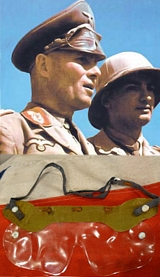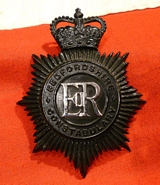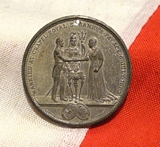Armouryantiques and militaria
The best militaria shop in the UK A Superb Case Hardened Steel Gun Lock Of a Greene Carbine 1856 Scarce British-Type Greene Carbine by Massachusetts Arms Company
Case-hardened swivel breech action with Maynard tape primer system. Lock marked: Queen's crown /VR/Mass.Arms Co./U.S.A./1856.
James Durell Greene was a prolific firearms inventor and determined to make his mark This carbine lock was manufactured by the Massachusetts Arms Company and exported to Great Britain after being inspected and stamped with the Queen's Crown by British inspectors in the USA. These were used by the British Cavalry in the Crimean War but re-exported to the USA after the Crimea War. These fine guns were deemed to be very accurate but the paper and linen cartridges of the time were criticised as being prone to swell in the damp and consequently the carbine did not find favour with the British Government. The carbine features an unusual "floating thimble" to obdurate the breech and an internal "pricker" that punctured the cartridge. It also featured Maynard Tape priming which was in the forefront of priming technology at the time and the mechanism for this is in perfect condition. The quality of workmanship is exceptional and it actions as crisply today as it did when it was made 158 years ago.
An exceptional item in outstanding condition. Only 2000 were manufactured and a complete carbine would be around ?3,000. read more
Price
on
Request
A Victorian, 1860's Queens Westminster Volunteers Silver Buckle
A super silver buckle, with excellent detail and quality. 6cm read more
120.00 GBP
A Pair of WW2 Gas Shield Eye Protectors 'Rommel' Type
Made of an early form of clear celluloid. Used to great effect by the Desert Rats in North Africa for sand protection. In fact Rommel used the very same protectors for that purpose, as one can see from the photos of Rommel, taken in Africa in 1943. Presumably he used captured British kit. Eye protectors Dated November 1942 read more
45.00 GBP
A Superb Group of WW2 Campaign Medals
A 5 medal Royal Naval group including Africa Star, Burma Star, Atlantic Star, 1939/45 Star and war medal. read more
220.00 GBP
Orginal 1950's Bedfordshire Constable's Police Helmet Plate
Black night patrol badge. Most desireable and highly collectable example. A very nice example. I lug lacking. Obsolete issue. read more
40.00 GBP
British Army GSM Campaign Service Medal Northern Ireland Bar. ERII
Issued to Gunner Ferguson Royal Artillery. The General Service Medal (1962 GSM, also sometimes referred to as the Campaign Service Medal), was introduced in 1962 to combine the General Service Medal (1918), as awarded to the Army and RAF, and the Naval General Service Medal (1915). The 1962 GSM was awarded until 2007, when it was replaced by the Operational Service Medal. read more
65.00 GBP
A Victorian British Connaught Rangers Officer's Helmet Tin
the case which is emblazoned with the makers name Hawkes and a brass plaque with the officer's name and regiment engraved, Addis Delacombe Esq Connaught Rangers. The 1st Battalion deployed to South Africa as part of 5th (Irish) Brigade which was commanded by Major-General Fitzroy Hart. The Rangers took part in numerous engagements during the Boer War.
The regiment took part in the Battle of Colenso on 15 December, part of the attempt to relieve the town of Ladysmith, besieged by Boer forces. The Rangers and the rest of the 5th (Hart's) Brigade, who were on the left flank, had been forced to perform over 20 minutes of drill before the advance. The Brigade suffered heavily during their participation in the battle, the Boers inflicting heavy casualties. The advance was met with a fire from three sides that forced them to withdraw. The battle ended in defeat for the British. That battle and two previous defeats at Magersfontein and Stormberg became known as 'Black Week'.
The Rangers fought at Spion Kop and the Tugela Heights during further attempts by General Sir Redvers Buller to relieve the besieged town of Ladysmith. In late February the siege of Ladysmith finally came to an end after it was relieved by British forces. The regiment was awarded the battle honour Relief of Ladysmith in addition to South Africa 1899?1902.
The 5th Brigade subsequently deployed to Kimberley and took part in further operations against the Boer guerillas.
The Rangers finally departed South Africa for Ireland after the Boer War ended in 1902, and were also awarded the theatre honour.
In 1908 the 1st Battalion arrived in India while the 2nd Battalion returned home to Ireland. The 1st and 2nd battalions of the regiment were given new Colours by HM King George V in 1911. The 2nd Battalion had left Ireland and was in England when the "war to end all wars", the First World War, began in August 1914. This tin is in untouched condition and could be much improved with simple cleaning but we have left 'as is' for those that prefer it as such. read more
200.00 GBP
Regular Army Long Service Good Conduct Medal Pair, Welsh Guards
GVR Army LSGC, with ?Regular Army? bar suspension (2730053 GDSMN C. S. HUGHES M.S.M. W.Gds).and his WW1 Civilisation Medal. One of England's premier regiments, and part of the Her Majesty's Household Guards Division. By the time of the First World War the most senior of the Guards Regiments, the Grenadier Guards, prepared to celebrate their 260th anniversary. At about the same time the youngest of the Guards Regiments, the Welsh Guards, was just being formed. During the Great War, the Guards served in every major campaign on the western front, from the early August days of 1914 at Mons, straight through to the occupation of Cologne after the Armistice in 1919. In 1915, at the request of King George V, the five Guards Regiments were brought together into their own division: The Guards Division. As their own division, the Guards continued to build a reputation as a very disciplined and dependable division that exceeded all expectations. At the end of the war, King George V honored the individual privates of the Guards Division with a title aside from Private. They would from that point on, respectfully be known as... Guardsmen. In December 1919 Guardsman Claude Hughes was awarded the MSM the Meritorious Service Medal, that medal was sadly lost read more
220.00 GBP
Royal Air Force Association Flag
Traditional blue ensign with RAF Assoc badge. Good order overall. Post war. 36 inches X 76 inches read more
125.00 GBP
Historical Medal For the Marriage of the Duke of York & Princess Mary 1893
Married At Chapel Royal St James's Palace 6 July 1893. Reverse with Duke and Duchess standing before Brittania Made by Spink and Sons London. Silvered on metal. 51mm. read more
85.00 GBP











